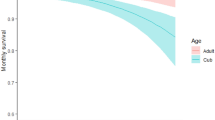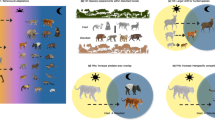Abstract
Northern vole populations exhibit large-scale, spatially synchronous population dynamics1,2. Such cases of population synchrony provide excellent opportunities for distinguishing between local intrinsic and regional extrinsic mechanisms of population regulation3. Analyses of large-scale survey data and theoretical modelling4,5,6 have indicated several plausible synchronizing mechanisms. It is difficult, however, to determine the most important one without detailed data on local demographic processes3,7. Here we combine results from two field studies in southeastern Norway—one identifies local demographic mechanisms and landscape-level annual synchrony among 28 enclosed experimental populations and the other examines region-level multi-annual synchrony in open natural populations. Despite fences eliminating predatory mammals and vole dispersal, the growth rates of the experimental populations were synchronized and moreover, perfectly linked with vole abundance in the region. The fates of 481 radio-marked voles showed that bird predation was the synchronizing mechanism. A higher frequency of risky dispersal movements in slowly growing populations appeared to accelerate predation rate. Thus, dispersal may induce a feedback-loop between predation and population growth that enhances synchrony.
This is a preview of subscription content, access via your institution
Access options
Subscribe to this journal
Receive 51 print issues and online access
$199.00 per year
only $3.90 per issue
Buy this article
- Purchase on Springer Link
- Instant access to full article PDF
Prices may be subject to local taxes which are calculated during checkout



Similar content being viewed by others
References
Ranta, E. & Kaitala, V. Travelling waves in vole population dynamics. Nature 390, 456 ( 1997).
Hansson, L. & Henttonen, H. Rodent dynamics as community processes. Trends Ecol. Evol. 3, 195– 200 (1988).
Bjørnstad, O. N., Ims, R. A. & Lambin, X. Spatial population dynamics: analysing patterns and processes of population synchrony. Trends Ecol. Evol. 14, 427–432 (1999).
Ranta, E., Kaitala, V. & Lundberg, V. P. The spatial dimension in population dynamics. Science 278, 1621–1623 ( 1997).
Grenfell, B. T. et al. Noise and determinism in synchronized sheep dynamics. Nature 394, 674–677 ( 1998).
Blasius, B., Huppert, A. & Stone, L. Complex dynamics and phase synchronization in spatially extended ecological systems. Nature 399, 354–359 (1999).
May, R. M. Crash tests for the real. Nature 398, 371 –372 (1999).
Steen, H., Ims, R. A. & Sonerud, G. A. Spatial and temporal patterns of small rodent population dynamics at a regional spatial scale. Ecology 77, 2365–2372 (1996).
Bjørnstad, O. N., Stenseth, N. C. & Saitoh, T. Synchrony and scaling in dynamics of voles and mice in northern Japan. Ecology 80, 622– 637 (1999).
Lambin, X. et al. Spatial asynchrony and periodic travelling wave in cyclic field vole populations. Proc. R. Soc. Lond. B 265, 1491–1496 (1998).
Korpimäki, E. & Krebs, C. J. Predation and population cycles of small mammals. A reassessment of the predation hypothesis. BioScience 46, 754–764 (1996)
Aars, J., Johannesen, E. & Ims, R. A. Demographic consequences of movements in subdivided root vole populations. Oikos 85, 204– 216 (1999).
Steen, H. Low survival of long distance dispersers of the root vole (Microtus oeconomus ). Ann. Zool. Fennici 31, 271– 274 (1994).
Ims, R. A. & Andreassen, H. Effects of experimental habitat fragmentation and connectivity on root vole demography. J. Anim. Ecol. 68, 839–852 ( 1999).
Andreassen, H. P. & Ims, R. A. The effect of experimental habitat destruction and patch isolation on space use and fitness parameters in female root vole Microtus oeconomus. J. Anim. Ecol. 67, 941–952 (1998).
Clobert, J. et al. (eds) Causes and Consequences of Dispersal at the Individual, Population and Community Level (Oxford Univ. Press, in the press).
Wolff, J. O. Population regulation in mammals: an evolutionary perspective. J. Anim. Ecol. 66, 1–13 (1997).
Ims, R. A. & Steen, H. Geographic synchrony in microtine population cycles: a theoretical evaluation of the role of nomadic avian predators. Oikos 57, 381–387 (1990).
Krebs, C. J. Population cycles visited. J. Mamm. 77, 8–24 (1996).
Stenseth, N. C. & Ims, R. A. The Biology of Lemmings (Academic, London, 1993).
Hanski, I. et al. Population oscillation of boreal rodents: regulation by mustelid predators leads to chaos. Nature 364, 232 –235 (1993).
Turchin, P. & Hanski, I. An empirically based model for latitudinal gradients in vole population dynamics. Am. Nat. 149 , 842–874 (1997).
Heikkilä, J., Below, A. & Hanski, I. Synchronous dynamics of microtine rodent populations on islands in Lake Inari in northern fennoscandia: evidence for regulation by mustelid predators. Oikos 70, 245– 252 (1994).
Korpimäki, E. & Norrdahl, K. Experimental reduction of predators reverses the crash phase sphase of small-rodent cycles. Ecology 79, 2448–2455 (1998).
Viitala, J. et al. Attraction of kestrels to vole scent marks visible in ultraviolet-light. Nature 373, 425–427 (1995).
Steen, H. Untangling the causes of dissappearance from a local population of root vole, Microtus oeconomus: a test of the regional synchrony hypothesis. Oikos 73, 65–72 ( 1995).
Reid, D. G., Krebs, C. J. & Kenney, A. Limitation of collared lemming population-growth at low densities by predation mortalilty. Oikos 73, 387–398 (1995).
Norrdahl, K. & Korpimäki, E. Mortality factors in a cyclic vole populations. Proc. R. Soc. Lond. B 261, 49–53 (1995).
Johannesen, E., Andreassen, H. P. & Steen, H. C-J-S modelling revealed no effect of radio collars on survival of root voles. J. Mamm. 78, 638–642 (1996).
Acknowledgements
We thank all the people who helped us during the field work at Evenstad; and J. Aars, E. Johannesen, X. Lambin and H. Steen for comments on the manuscript. This study was supported by the Research Council of Norway.
Author information
Authors and Affiliations
Corresponding author
Rights and permissions
About this article
Cite this article
Ims, R., Andreassen, H. Spatial synchronization of vole population dynamics by predatory birds . Nature 408, 194–196 (2000). https://doi.org/10.1038/35041562
Received:
Accepted:
Issue Date:
DOI: https://doi.org/10.1038/35041562
This article is cited by
-
Synchronous decline of native bitterling population detected from 9 years of survey in rivers and agricultural ditches around Lake Kasumigaura, Japan
Ichthyological Research (2023)
-
Body size dependent dispersal influences stability in heterogeneous metacommunities
Scientific Reports (2021)
-
Adaptive individual variation in phenological responses to perceived predation levels
Nature Communications (2019)
-
Population fluctuations and spatial synchrony in an arboreal rodent
Oecologia (2019)
-
How general are generalist parasites? The small mammal part of the Lyme disease transmission cycle in two ecosystems in northern Europe
Oecologia (2019)
Comments
By submitting a comment you agree to abide by our Terms and Community Guidelines. If you find something abusive or that does not comply with our terms or guidelines please flag it as inappropriate.



